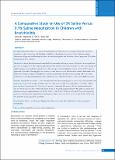Please use this identifier to cite or link to this item:
https://hdl.handle.net/20.500.14356/1789Full metadata record
| DC Field | Value | Language |
|---|---|---|
| dc.contributor.author | Ojha, A R | - |
| dc.contributor.author | Mathema, S | - |
| dc.contributor.author | Sah, S | - |
| dc.contributor.author | Aryal, U R | - |
| dc.date.accessioned | 2023-05-23T04:57:16Z | - |
| dc.date.available | 2023-05-23T04:57:16Z | - |
| dc.date.issued | 2014 | - |
| dc.identifier.citation | OjhaA. R., MathemaS., SahS., & AryalU. R. (2014). A Comparative Study on Use of 3% Saline Versus 0.9% Saline Nebulization in Children with Bronchiolitis. Journal of Nepal Health Research Council. https://doi.org/10.33314/jnhrc.v0i0.435 | en_US |
| dc.identifier.issn | Print ISSN: 1727-5482; Online ISSN: 1999-6217 | - |
| dc.identifier.uri | http://103.69.126.140:8080/handle/20.500.14356/1789 | - |
| dc.description | Original Article | en_US |
| dc.description.abstract | Abstract Background: Bronchiolitis is a common clinical problem in children below 2 years presenting with respiratory symptoms. As there is necrosis and sloughing of epithelial cells, edema, increased secretion of mucus causing obstruction of large and small airways we aim to see the clinical profile and the effect of use of hypertonic (3%) saline nebulization in these children. Methods: A double blind randomized controlled trial was conducted at department of Pediatrics, in a hospital from July 2012 to August 2013. The computer generated random number was used to select the case and control group. All eligible patients were randomly assigned to one of two groups: receiving inhalation of 4 ml normal (0.9%) saline or hypertonic (3%) saline. Treating physicians, researchers and nurses were all blinded of the solution. Both saline were kept in two identical containers and labeled as solution A and solution B. Patients in each group will receive three treatments on each day of hospitalization and clinical score were obtained 30 minutes before each inhalation session. Results: Bronchiolitis accounted 11.26% of total admissions. Their mean age (±SD) was 8.56 (±5.013) months with range from 45 days to 24 months. A total of 53 (74%) male were enrolled in the study. Fifty-seven (79%) children were less than 12 months and 15 (21%) were 12 months - 24 months. The mean (±SD) for duration of hospital stay was 44.82 (±23.15) and 43.60 (±28.25) for 3% and 0.9% group respectively (p=0.86). Likewise, mean (SD) duration of oxygen supplementation was 32.50 (±20.44) and 34.50 (±26.03) for 3% and 0.9% group respectively (p=0.85). Moreover, time required for normalization of clinical score was 36.79 (±19.53) and 38.34 (±26.67) for 3% and 0.9% group respectively (p=0.80). Conclusions: There is no advantage of hypertonic saline over normal saline nebulization in the management bronchiolitis.  Keywords: bronchiolitis; hypertonic saline; nebulization. | en_US |
| dc.language.iso | en | en_US |
| dc.publisher | Nepal Health Research Council | en_US |
| dc.relation.ispartofseries | Jan-April, 2014;435 | - |
| dc.subject | Bronchiolitis | en_US |
| dc.subject | Hypertonic saline | en_US |
| dc.subject | Nebulization | en_US |
| dc.title | A Comparative Study on Use of 3% Saline Versus 0.9% Saline Nebulization in Children with Bronchiolitis | en_US |
| dc.type | Journal Article | en_US |
| local.journal.category | Original Article | - |
| Appears in Collections: | Vol. 12 No. 1 Issue 26 Jan - Apr, 2014 | |
Files in This Item:
| File | Description | Size | Format | |
|---|---|---|---|---|
| 435-Article Text-581-1-10-20140709.pdf | Fulltext Download | 373.62 kB | Adobe PDF |  View/Open |
Items in DSpace are protected by copyright, with all rights reserved, unless otherwise indicated.
